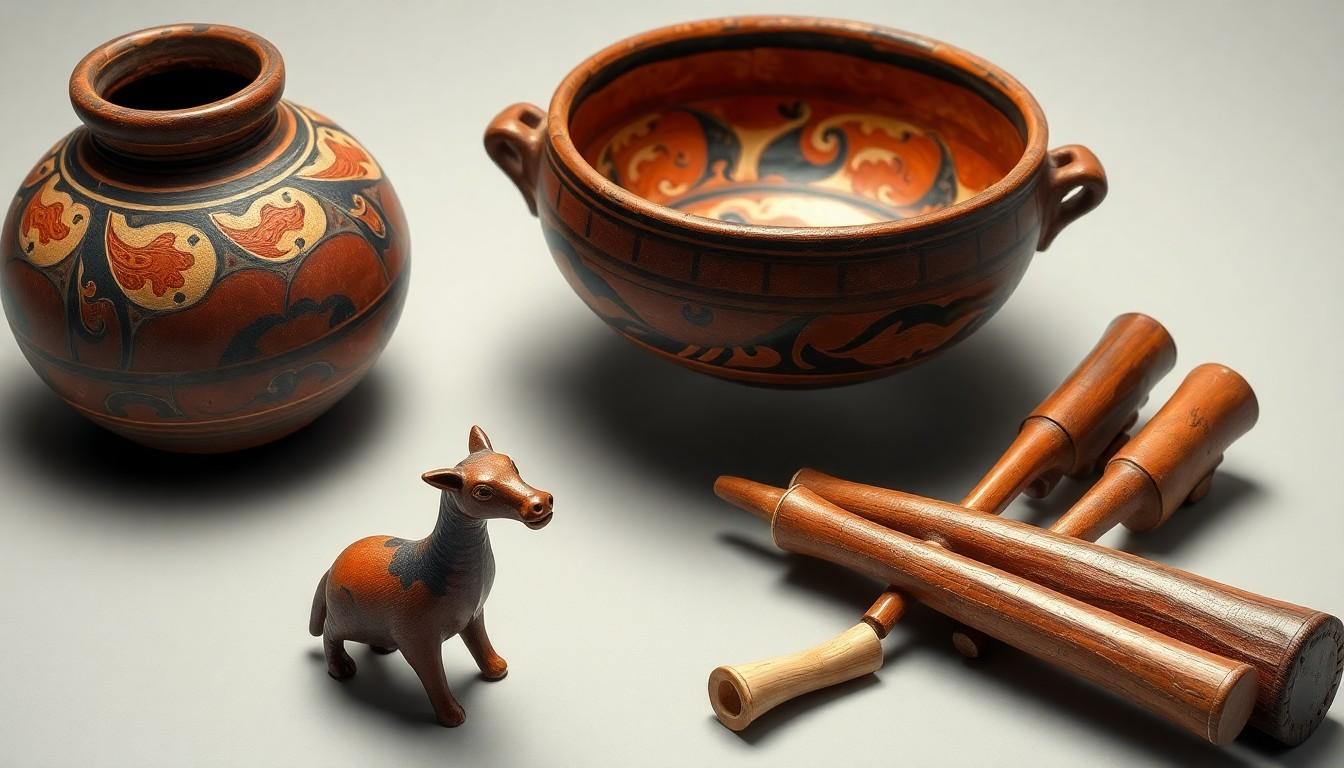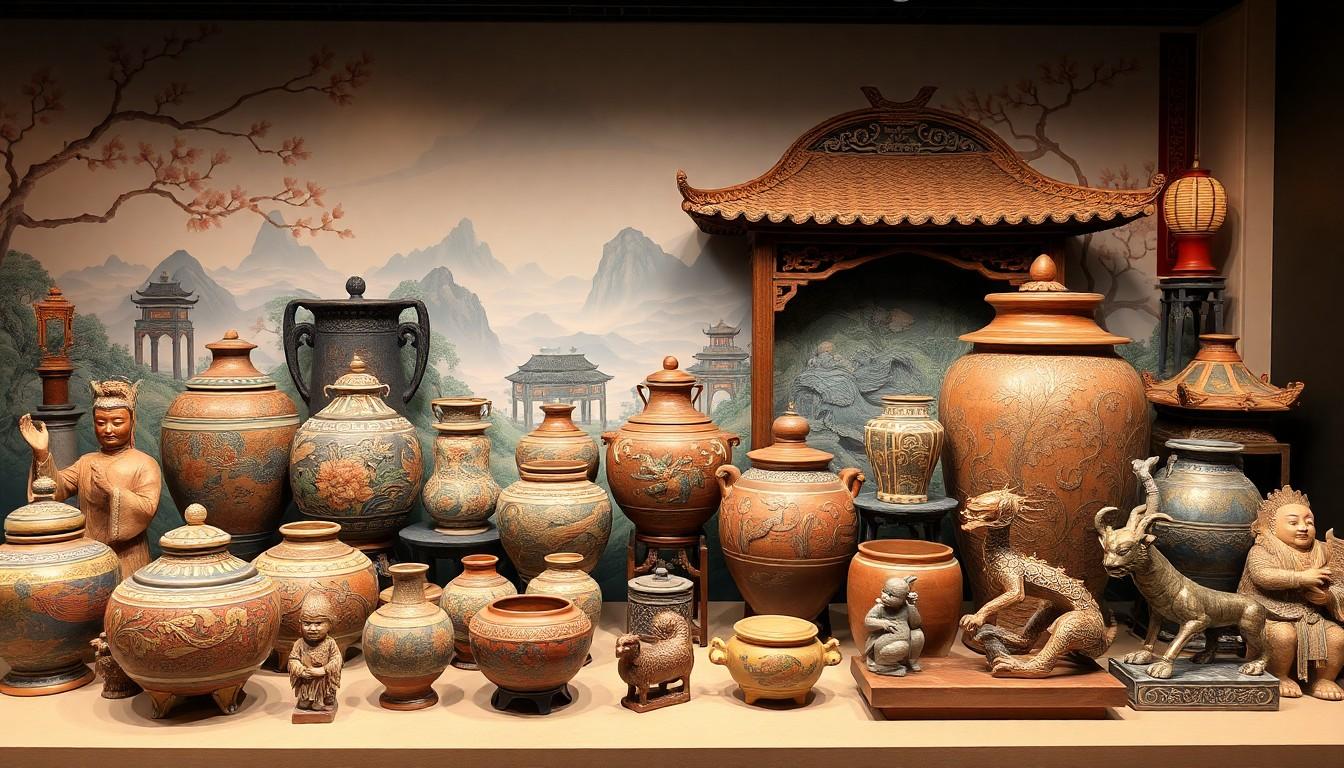Art is like a time machine, whisking us through the vibrant eras of Chinese history. From the majestic strokes of ancient calligraphy to the bold colors of contemporary pieces, each period tells a unique story. But how did these styles evolve?
How Did Art Styles Change During Each Era of Chinese History?
Chinese art history spans thousands of years, encompassing various styles and techniques. Each era reflects significant cultural and political changes. The Neolithic period initiated pottery and early sculpture, emphasizing communal lifestyle and rituals. During the Shang dynasty, bronze casting emerged, showcasing intricate designs and religious significance.
The Zhou dynasty expanded artistic expressions, fostering developments in poetry and calligraphy. Calligraphy became highly regarded, representing both art and scholarship. In the Han dynasty, the emergence of ink painting and silk banners marked a transition to more sophisticated designs. Artists began to explore narrative themes, particularly in landscape and figural art.
Buddhism’s arrival in the Tang dynasty drastically influenced artistic forms. Sculptural work and murals flourished during this time, with vibrant colors and dynamic poses. The Song dynasty further refined landscape painting, characterized by detailed nature depictions and a focus on tranquility and harmony.
During the Yuan dynasty, the influence of Mongol rule led to the blending of various styles. It marked a period of innovation, especially in literati painting, emphasizing expression over form. The Ming dynasty completed this evolution, renown for porcelain and elaborate architectural designs.
The Qing dynasty continued to amalgamate influences while promoting traditional techniques. Export art flourished, appealing to international audiences. Throughout these periods, movements and techniques adapted to changing societal norms, enriching China’s artistic legacy. Artistic styles evolved not only with technology but also in response to spiritual, philosophical, and political shifts, shaping the rich tapestry of Chinese art history.
Prehistoric Art
Prehistoric art in China marks the foundation of artistic expression. This early art showcases human creativity and cultural development.
Characteristics of Prehistoric Art
Ceramic pottery stands out as a primary element of prehistoric art. It exhibits various styles, including painted and engraved designs. Sculptural forms also appear, often depicting animals or human figures. Texture and form play critical roles, enhancing the visual appeal. Colorful pigments reveal an understanding of aesthetic principles. Evidence indicates that these artworks conveyed social or spiritual significance.
Notable Artifacts
Numerous artifacts date back to the Neolithic period. The Majiabang culture produced distinctive pottery decorated with intricate red and black patterns. Yangshao culture artifacts demonstrate advanced techniques, including coiling and molding. Jiahu relics, including flutes made from bone, indicate early musical expression. Banpo site discoveries reveal elaborate pottery and figurines, illustrating communal life. These artifacts highlight the diverse artistic practices present during this era.
Ancient Dynasties
Chinese art began evolving through various historical periods, each contributing unique styles that reflect socio-political changes and cultural attitudes. The artistry from these eras provides insight into the civilization’s developing narrative.
Shang and Zhou Dynasties
The Shang dynasty (1600–1046 BC) showcased sophisticated bronze casting, producing ceremonial vessels and weaponry. Intricate designs demonstrated advanced metallurgical skills. Calligraphy began to flourish during the Zhou dynasty (1046–256 BC), elevating the written word to an esteemed art form. Poets and scholars favored elegant inscriptions on bronze and other artifacts. The development of early philosophical texts, accompanied by artistic expression, played a vital role in shaping cultural identity.
Qin and Han Dynasties
The Qin dynasty (221–206 BC) marked an era of monumental architecture, notably the Terracotta Army, which reflected beliefs about the afterlife. Art shifted towards depicting realism and narrative scenes during the Han dynasty (206 BC–220 AD). Innovations included ink painting and the use of silk, allowing detailed illustrations in historical texts and banners. Sculptures demonstrated a blend of figurative and abstract elements, often celebrating human achievement and divine favor. These artistic transformations provided a rich legacy that influenced subsequent Chinese artistic movements.
The Three Kingdoms to Tang Dynasty
Art styles during the Three Kingdoms to Tang Dynasty era reflect the profound influences of political fragmentation, cultural interactions, and religious motifs. Artistic expression thrived amid the turbulent landscape, shaped by the confluence of native traditions and the introduction of foreign elements such as Buddhism.
Influences on Art Styles
Political changes profoundly impacted artistic direction. Regional powers promoted diverse aesthetic values, leading to a tapestry of artistic styles. Cultural exchange played a crucial role, with trade routes facilitating interactions between Chinese artists and those from neighboring regions. The integration of Buddhist themes emerged as a direct influence, enriching visual narratives and introducing new iconography.
Major Art Forms and Innovations
Sculpture achieved significant advancements during this era. Figures carved from stone and wood showcased Buddhist imagery alongside traditional motifs, creating dynamic representations. Paintings on silk began to flourish, capturing daily life, landscapes, and religious themes. Innovations in techniques also saw the development of more sophisticated ink-wash methods, allowing artists to create ethereal effects and depth in their compositions.
Song and Yuan Dynasties
During the Song and Yuan dynasties, Chinese art experienced significant transformation, particularly in landscape painting and calligraphy.
Evolution of Landscape Painting
Landscape painting reached new heights during the Song dynasty. Artists emphasized harmony and tranquility in their works, reflecting philosophical ideals rooted in Daoism and Confucianism. Notable painters, including Fan Kuan and Guo Xi, utilized precise brushwork and perspective techniques, creating depth and spatial illusions. Mountains, rivers, and natural elements became central themes, conveying a sense of connection between humanity and nature. By the Yuan dynasty, literati painting emerged, where scholars integrated personal expression with traditional techniques. Artists like Ni Zan prioritized individual style, often portraying more abstract and symbolic landscapes, shifting the focus from realism to interpretation. This evolution reflected broader cultural trends in valuing personal interpretation over strict adherence to conventions.
Impact of Calligraphy
Artistic expression in calligraphy flourished during the Song and Yuan dynasties. Calligraphy transitioned from merely a written form to a revered art discipline. Esteemed calligraphers, such as Su Shi and Zhao Mengfu, showcased their skills through various scripts, emphasizing aesthetic and emotional resonance. Calligraphy in this era highlighted not just the beauty of characters but also the personality of the artist. Scholars often infused their writings with philosophical and cultural reflections, merging art with intellectual pursuits. As a result, it became an essential component of literati culture, linking poetry, painting, and calligraphy into a harmonious aesthetic tradition. The trends established during these dynasties significantly shaped the trajectory of Chinese calligraphy for centuries.
Ming and Qing Dynasties
Art during the Ming and Qing dynasties showcases a rich evolution in style and subject matter. This period marked significant developments in both traditional practices and new influences.
Shift in Subject Matter
Shifts in subject matter became prominent during the Ming dynasty. Artists explored themes beyond traditional motifs, incorporating landscapes, animals, and daily life. The emergence of porcelain painting featured intricate designs that reflected nature and cultural narratives. Qing artists further embraced diverse subjects, including historical figures and mythology. Additionally, portraiture gained prominence, capturing the likenesses of emperors and dignitaries. These changes indicated a broader engagement with society and culture, allowing artists to connect more deeply with their audiences.
Interaction with Western Art
Interactions with Western art began during the later years of the Ming dynasty. Trade routes and the arrival of European missionaries introduced new artistic techniques and concepts. Artists began adopting perspective and chiaroscuro, enhancing the depth of their works. The Qing dynasty saw continued exposure to Western styles, leading to a fusion of Eastern and Western elements in painting and porcelain. Notably, the influence of oil painting brought a new dimension to traditional Chinese art. This synthesis of styles demonstrated the adaptability of Chinese artists, enriching their artistic expression while appealing to both local and international audiences.
Modern and Contemporary Art
Modern and contemporary Chinese art reflects significant transformations influenced by various factors.
Responses to Political Changes
Political dynamics during the 20th century greatly impacted artistic expression. Artists responded to events such as the Cultural Revolution, which imposed restrictions on artistic freedom. Many adopted subversive methods to convey their messages, leading to innovative styles and themes. Works produced during this period often commented on social issues and explored personal experiences. In the post-Mao era, a resurgence in individualism emerged, allowing artists to freely explore contemporary topics. By embracing globalization, they combined traditional techniques with modern concepts, fostering a vibrant artistic landscape.
Global Influence of Chinese Art
Globalization has dramatically shaped contemporary Chinese art. Influential artists now engage with international trends, creating work that resonates beyond borders. Participation in major global exhibitions has increased visibility for Chinese art, attracting worldwide attention. Modern techniques and materials blend seamlessly with age-old traditions, showcasing a dynamic fusion. Collaboration between local and international artists fosters innovative approaches, enriching the global art scene. Collectors and institutions around the world recognize the significance of Chinese art, further solidifying its impact on contemporary culture.
Overview of Chinese Art History
The evolution of Chinese art reflects a rich tapestry of cultural and historical narratives. Each era contributed unique styles and techniques that resonate with the societal shifts of the time. From the intricate pottery of the Neolithic period to the vibrant expressions of contemporary art, these transformations reveal the adaptability and resilience of Chinese artists.
As they navigated political changes and cultural exchanges, artists continually redefined their craft. This ongoing dialogue between tradition and innovation ensures that Chinese art remains a vital part of the global artistic landscape. The journey through its history not only highlights artistic achievements but also offers a deeper understanding of China’s cultural identity.


